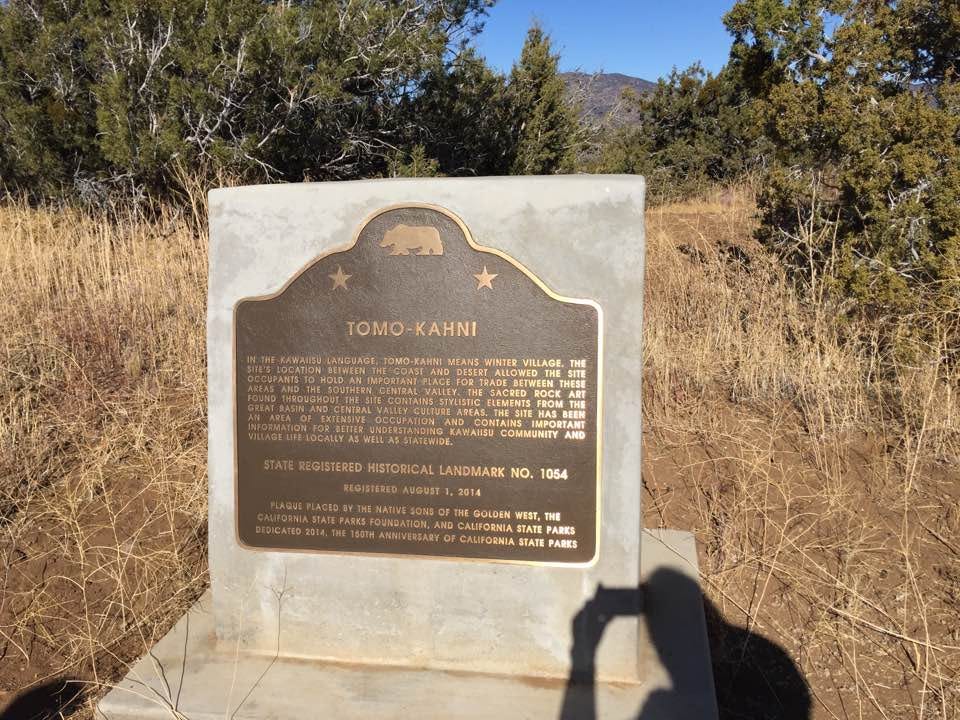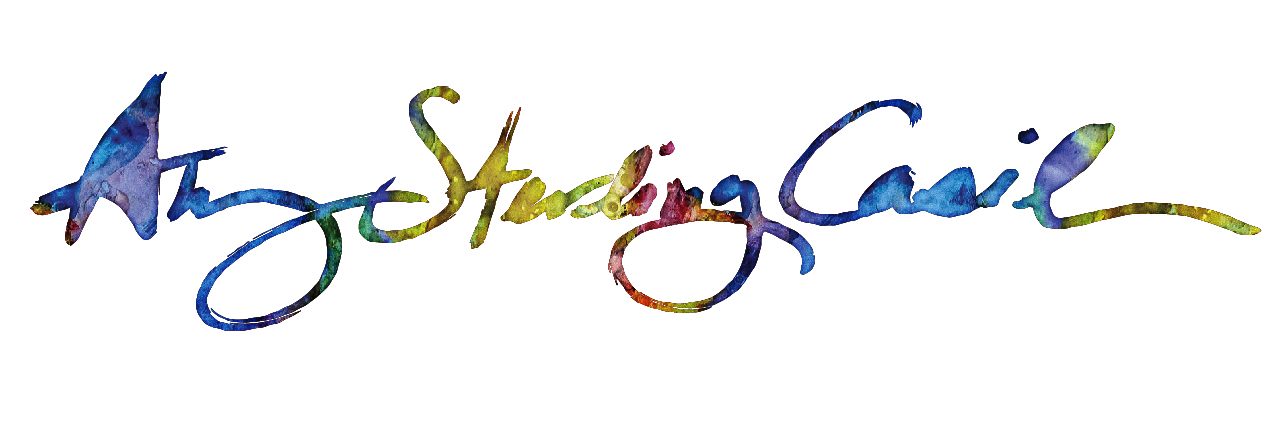What does an ancient Native American community say about public and private places, the environment, and our culture?
A couple of weeks ago, I took a rare day off for a rare opportunity: a hiking trip to California’s Tomo-Kahni State Park sponsored by the California Rock Art Foundation.
Despite being a 5th-generation Californian who’s hiked many of the state’s trails, I’d not only never heard of the park before, I hadn’t heard of the Kawaiisu people, some of whom lived at Tomo-Kahni until the 1930s. All I knew was I was traveling west from the 14 out of Mojave on what was to me, “that back road from Barstow to Bakersfield.”

© 2019 Amy Sterling Casil — State park commemorative plaque — hidden from the road due to risk of defacement and vandalism of Native American artifacts
A couple of Google reviews for Tomo-Kahni say “there’s nothing there.” This is a good thing because there’s no real security at the park. Anyone could drive out there, circumvent the gate, and wander around doing anything they liked.

Tomo-Kahni means “winter home” in the language of the Kawaiisu people who lived there for thousands of years. The only petroglyph on site lasted one week after the park was dedicated in 1993. Perhaps by way of celebration, someone busted in and put their own version of a “Thunderbird” on the right side of the rock face. The damage had to be removed, obscuring some of the real rock art. The petroglyphs now visible show a bighorn sheep and a dog. Meredith saw three men with bows and arrows.
Walking quietly, I began to feel the way the Kawaiisu people lived before Europeans came and set up businesses as diverse as cattle and cement and pastimes like lynchings and massacres. I listened in wonder as our guides explained that the hills, now sparsely dotted with juniper and sagebrush, had once been covered in native oaks. The oaks had been felled for wood use by European settlers; somehow they’d survived thousands of years of occupation by the Kawaiisu and even more ancient Native American people.

Listening to our guides from the Tehachapi Museum and the California Rock Art Foundation, pictures formed in my mind. I felt hearts beating and the breath of lives that had gone on before. An entirely different way of life from the one I knew had gone on at Tomo-Kahni for hundreds — even thousands — of years.

Nearly at the top of one overlooking hill was one of the few remaining oaks and a cave which was a healing place. Another cave slightly to the north was a refuge for women during their monthly menstrual cycles. In the canyon leading up, a place of grieving, where Kawaiisu mothers fled a massacre with their babies. The mothers hid in rock crevices. Our guides said the mothers grieved because the babies suffocated while their mothers were hiding. I think, but am not sure, that the mothers were fleeing the Keysville Massacre in 1863, in which Native American men were killed by U.S. Federal troops from Fort Tejon.
We came to the rock shelter and cave paintings after a steep and winding climb. As we rounded the last trail switchback, a shadow flashed over us. The hair stood up on the back of my neck and I looked up to see the round cream-colored face and broad wings of a barn owl.

The shelter is not large, but it overlooks a broad valley dotted with dramatic rock formations and junipers. There is no way to know how old the paintings are, or how many people made them.




I saw many animals while on this hike. As we hiked out beside Tomo-Kahni’s now-nearly-dry stream, at least 20 quail took flight. Some of the pictures in the rock shelter may be of the rock baby and perhaps not drawn directly by people. I felt they might be so; stories of the Kawaiisu speak of it.

According to some official records, the Kawaiisu people don’t even exist. They’re not a federally-recognized tribe. I hadn’t known until this hike that in the 1920s and 30s, the U.S. government worked hard to convince indigenous people they didn’t need to be federally-recognized. Apparently word went out that it was bad to be federally-recognized. So, among many others, the Kawaiisu people declined the recognition, which includes both good and bad: yes to aid, yes to reservations, no to many other opportunities.
I know our guides said that the Kawaiisu descendants in Tehachapi helped to raise money so the state could purchase the land where Tomo-Kahni sits. I can’t find documentation of this but have no doubt it’s true. The land is not that far as the crow flies from Tejon Ranch, one of the largest privately-owned ranches not only in California, but the entire nation. The massacre of Kawaiisu men and the mothers hiding with their babies is intertwined with the story of Tejon Ranch — which ought to make any of us Californians blanch — but nobody seems to care and they still make PBS documentaries and Huell Howser videos about how awesome the ranch is. The Tejon people are federally recognized but my understanding is that some native people who live on or near the Tejon Ranch aren’t. If you want to know what type of people the white Tejon ranchers are you can watch the movie Chinatown and compare to the bad guy Noah Cross portrayed by John Huston.
“She’s my sister! She’s my daughter! My sister! My daughter!”
“You see, Mister Gittes,” Cross says to Jack Nicholson’s detective Jake Gittes, “most men never have to face the fact that, at the right time, they’re capable of . . . anything.”
If you haven’t seen the film, it’s a Hollywood classic. While watching it again the other day, I realized that director Roman Polanski may well have been driven out of the U.S. for pedophilia with teens he was not related to by people whose illegal sins were far worse (incest is only one of the many sins of Cross in Chinatown).
We go from the red, evil city (Los Angeles) to the fresh air and now-oakless landscape where the Kawaiisu once raised their children, hunted and fished, and kept their lives from one generation to the next.
The ground where people once have lived darkens, said Christine Clarkson, a college instructor and CRAF Executive Director who came with her family and led the California Rock Art Foundation portion of the tour. All around where the Kawaiisu people had lived were stones which had once been in a circle and which had been moved into mysterious irregular shapes by the earth itself over the years. Dust, fire, soot, grease, footsteps of ages, ground into the earth itself.
They say that Picasso visited the caves of Lascaux in France and exited white-faced, muttering “We have invented nothing new.”
I realized how many times I had seen darkened soil while hiking. How many times I have seen the stones where mothers and daughters ground the acorns. Yet I hadn’t seen the quail flying so since I was a young girl, hunting with my grandfather. My heart lifted to hear and feel them.
My heart sinks to feel how much we have lost. Why couldn’t the Kawaiisu people keep living there? By the 1920s and 30s, their way of life had been swallowed up. Swallowed in part for the wicked red city, as the cement plant in the nearby “company town” of Monolith made materials for Mulholland’s Los Angeles Aqueduct.
People with the desire to hike into the wild and empty spaces may not have the desire to link threads or tell stories. They may see what remains today, but not be able to feel what once was there; I couldn’t feel the oaks that had been cut down, never to regrow, until I was told about them. After that, their spirits were at every turn.
What kind of soul-dead fool would scratch a false Thunderbird on hundreds- or thousands- of year old sacred art?
I want to say such fools are no longer with us, but that’s hardly the case. The marker for Tomo-Kahni Park faces inward, not outward, and is hidden from the eyes of eager vandals by junipers and rocks.
There are so many places where the people who came before lived. Today we live in pollution, in houses that will crumble to less than nothing if we are gone even 25 years, much less hundreds or thousands of years.
But perhaps the dark earth will remain, because as always, we track in our dirt, cook our food, and go about our lives. What will they say of us when they make their mark on our once-proud monuments?

Leave a Reply